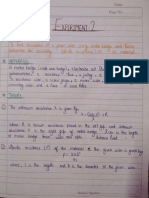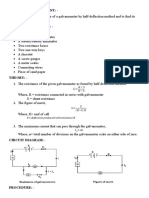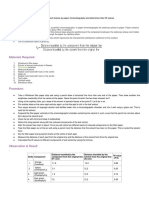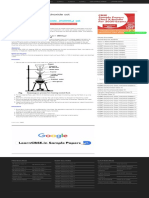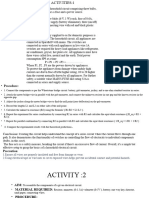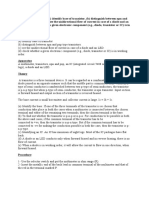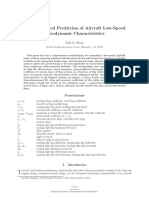AC Sonometer
AC Sonometer
Uploaded by
kirtiCopyright:
Available Formats
AC Sonometer
AC Sonometer
Uploaded by
kirtiOriginal Title
Copyright
Available Formats
Share this document
Did you find this document useful?
Is this content inappropriate?
Copyright:
Available Formats
AC Sonometer
AC Sonometer
Uploaded by
kirtiCopyright:
Available Formats
A.
C SONOMETER
Aim: To find the frequency of AC mains using sonometer.
Apparatus Required: Sonometer table, set of eight tuning forks, ½ kg hanger, seven ½ kg slotted weights,
clamp, stand, rubber pad, paper rider, meter scale.
Theory:
Let the alternating current have frequency so that the frequency of magnetization of the electromagnet v E
becomes 2v.
Let a loaded stretched soft iron wire have resonant length l , with electromagnet. Let a tuning fork of
frequency v, have resonant length l2.
Then, from law of length,
vEl1=vTl2.
𝒍𝟐
vE= VT(𝒍𝟏)
Hence, frequency of alternating current,
𝟏 𝟏 𝒍𝟐
v = 𝟐 𝒗𝑬 = 𝟐 𝒗𝑻 (𝒍𝟏)
Which can be calculated.
The natural frequency of oscillation for a stretched wire of length L and mass m and tension T is
1 𝑇
V=2𝐿 √µ
𝑚𝑎𝑠𝑠 𝑚
Here, µ=𝑙𝑒𝑛𝑔𝑡ℎ = 𝑙
Circuit Diagram:
Procedure:
(i) Place the sonometer on table as shown.
(ii) Test the pulley and make it frictionless by oiling.
(iii) Put suitable maximum weights in hanger.
(iv) Move wooden bridges P, P outward to include maximum length of wire (AB) between them.
(v) Decrease the length of wire by moving both bridges equally inwardly.
(vi) Go on decreasing the length till sonometer wire starts vibrating (a sound is heard).
(vii) Adjust the length for maximum amplitude of vibration (Maximum sound)
(viii) Measure the length of wire AB between edges of two bridges and record in length decreasing
column.
(ix) Bring the two bridges closer and then adjust the length for maximum amplitude by increasing
it.
(x) Measure the length and record it in length increasing column.
(xi) Now take a tuning fork of minimum frequency and adjust wire length with a tuning fork.
(xii) Repeat step (xi) with tuning forks of other known frequencies.
(xiii) Record your observations.
Observations and Calculation:
1. Weight suspended to produce on wire, T=1.5 Kg
2. TABLE FOR FREQUENCY AND LENGTH
Resonant length of wire
Frequency of
electromagnet Frequency of
S. No and tuning Length Length Mean = electromagnet
forks used v decreasing (l’) increasing 𝐥’+𝐥’’
( 𝟐 )=l (cm) vE (Hz)
(Hz) cm (l’’)
Cm
1.
2.
3.
4
5.
Calculations:
1) Mean of vE=______________
𝑣𝐸
2) Frequency of Alternating current, v= 2 = ____ Hz
Difference
3) % Error = Actual Value X 100
Result:
The frequency of alternating current = _____ Hz
Percentage error:
The actual frequency = ____ Hz
Difference = _____ Hz
𝐷𝑖𝑓𝑓𝑒𝑟𝑒𝑛𝑐𝑒
% Error = 𝐴𝑐𝑡𝑢𝑎𝑙 𝑉𝑎𝑙𝑢𝑒 𝑋 100= ______ %
This error is within limits of experimental error.
Precautions:
(i) All precautions of sonometer should be observed.
(ii) Wire should be of soft iron/ magnetic material.
(iii) Tip of electromagnet should be close to wire in middle.
(iv) Length should be noted when amplitude is maximum.
Sources of error:
(i) Wire not be of uniform cross section area.
(ii) Pulley may not be frictionless.
(iii) Weights may not be correct.
(iv) Knife edges may not be sharp.
(v) Main frequency may not be stable.
You might also like
- Study of The Role of Emulsifying Agents in Stabilizing The Emulsion of Different OilsDocument1 pageStudy of The Role of Emulsifying Agents in Stabilizing The Emulsion of Different OilsauroraborealisacNo ratings yet
- Expt.8 (To Find Focal Length of Concave Lens Using Convex Lens)Document4 pagesExpt.8 (To Find Focal Length of Concave Lens Using Convex Lens)ayushmanjee130378% (9)
- Frequency of Ac MainsDocument2 pagesFrequency of Ac Mainsharsh50% (4)
- AC Sonometer ExperimentDocument6 pagesAC Sonometer ExperimentAnshulNo ratings yet
- Experiment 2 PhysicsDocument5 pagesExperiment 2 Physicsansh BeniwalNo ratings yet
- Experiment 8Document5 pagesExperiment 8Gurdeep Singh Saggu100% (2)
- 07 Galvanometer - 2Document2 pages07 Galvanometer - 2Muhammad SufyanNo ratings yet
- Meter Bridge-Specific ResistanceDocument3 pagesMeter Bridge-Specific ResistancekirtiNo ratings yet
- Refractive Index of A Liquid by Using Convex LensDocument3 pagesRefractive Index of A Liquid by Using Convex LensHEADLINES DAILY100% (1)
- Half Deflection of GalvanometerDocument3 pagesHalf Deflection of GalvanometerTamanna NayakNo ratings yet
- To Find The Focal Length of Concave MirrorDocument5 pagesTo Find The Focal Length of Concave Mirrorsyedasra5610% (1)
- To Verify The Laws of The Parallel Combination of ResistancesDocument3 pagesTo Verify The Laws of The Parallel Combination of Resistancesanamika7005865200No ratings yet
- Focal Length of Convex LensDocument5 pagesFocal Length of Convex LensHey AnuragNo ratings yet
- Half Deflection ReadingsDocument5 pagesHalf Deflection ReadingsAritra RoyNo ratings yet
- To Verify The Laws of Combination (Series) of Resistances Using A Metre BridgeDocument3 pagesTo Verify The Laws of Combination (Series) of Resistances Using A Metre Bridgeatikshpro3004No ratings yet
- To Determine Angle of Minimum Deviation For A Given Prism by Plotting A Graph Between Angle of Incidence and Angle of Deviation PDFDocument6 pagesTo Determine Angle of Minimum Deviation For A Given Prism by Plotting A Graph Between Angle of Incidence and Angle of Deviation PDFriyanmedhi04No ratings yet
- Experiment 3 - Meterbridge ParallelDocument7 pagesExperiment 3 - Meterbridge Parallelayushmanjee1303100% (1)
- To Separate The Pigments Extract From Spinach Leaves by Paper Chromatography and Determine Their RF ValuesDocument2 pagesTo Separate The Pigments Extract From Spinach Leaves by Paper Chromatography and Determine Their RF ValuesBipul KumarNo ratings yet
- Physics Experiment - 2Document3 pagesPhysics Experiment - 2Sandipan Samanta0% (1)
- 7.concave MirrorDocument3 pages7.concave Mirrorkirti100% (1)
- Focal Length of Convex Lens by Plotting The Graph Between U and VDocument7 pagesFocal Length of Convex Lens by Plotting The Graph Between U and VSwapnil Khora100% (1)
- To Verify The Laws of Combination of Resistances in Series Using A Meter BridgeDocument3 pagesTo Verify The Laws of Combination of Resistances in Series Using A Meter BridgeMinato DragneelNo ratings yet
- Experiment No. 2 Meter BridgeDocument5 pagesExperiment No. 2 Meter Bridgepeniwal magicsNo ratings yet
- Activity Activity Activity Activity Activity: ActivitiesDocument2 pagesActivity Activity Activity Activity Activity: ActivitiesHarsh ShahNo ratings yet
- Drawn Diagram of Given Open CKTDocument2 pagesDrawn Diagram of Given Open CKTRbcNo ratings yet
- To Prepare Ferric Hydroxide Sol - Chemistry Practical Class 12 - Learn CBSEDocument1 pageTo Prepare Ferric Hydroxide Sol - Chemistry Practical Class 12 - Learn CBSESujal JhaNo ratings yet
- To Determine Resistance of A Galvanometer by Half-Deflection Method and To Find Its Figure of MeritDocument3 pagesTo Determine Resistance of A Galvanometer by Half-Deflection Method and To Find Its Figure of Meritatikshpro3004100% (3)
- Physics Practicals - XII (24-25)Document2 pagesPhysics Practicals - XII (24-25)Shubhra khatri50% (2)
- To Assemble A Household Circuit Comprising Three Bulbs, Three (On/off) Switches A Fuse and A Power Source.Document4 pagesTo Assemble A Household Circuit Comprising Three Bulbs, Three (On/off) Switches A Fuse and A Power Source.Study Material100% (1)
- Focal Lenght of Convex Mirror Using Convex LensDocument2 pagesFocal Lenght of Convex Mirror Using Convex LensAmit Sutar100% (4)
- Activity Notes BookDocument12 pagesActivity Notes Bookkaran singh class 11 aNo ratings yet
- Variation of Cell Potential in ZnZn2 Cu2+Cu With Change in Concentration of Electrolytes (CuSO4 or ZnSO4) at Room TemperatureDocument5 pagesVariation of Cell Potential in ZnZn2 Cu2+Cu With Change in Concentration of Electrolytes (CuSO4 or ZnSO4) at Room TemperatureauroraborealisacNo ratings yet
- Asm1 5078Document4 pagesAsm1 5078Maya NairNo ratings yet
- Law of Resistance (Parallel) PDFDocument12 pagesLaw of Resistance (Parallel) PDFAmogha kantakNo ratings yet
- To Determine Resistance Per CM of A Given Wire by Plotting A Graph of Potential Difference Versus Current and Reading of PraticalDocument14 pagesTo Determine Resistance Per CM of A Given Wire by Plotting A Graph of Potential Difference Versus Current and Reading of PraticalSATYAM X-C100% (5)
- To Determine The Refractive Index Using Travelling MicroscopeDocument4 pagesTo Determine The Refractive Index Using Travelling MicroscopeIrfan Sergio100% (1)
- Experiment No: 4 Galvanometers Into VoltmeterDocument4 pagesExperiment No: 4 Galvanometers Into VoltmeterAritra RoyNo ratings yet
- Certificate: Polarisation of Light Using Two PolaroidsDocument9 pagesCertificate: Polarisation of Light Using Two PolaroidsKanishq BawejaNo ratings yet
- Figure of Merit Expt.4Document4 pagesFigure of Merit Expt.4Priyanshu Kumar90% (10)
- Focal Length of A Convex Mirror Using Convex Lens 1Document2 pagesFocal Length of A Convex Mirror Using Convex Lens 1mahatimahidevkar80% (5)
- Physics Practical 22-23Document25 pagesPhysics Practical 22-23Arnav100% (1)
- Travelling MicroscopeDocument3 pagesTravelling MicroscopeRohan Mohanty100% (1)
- Physics Activity FileDocument16 pagesPhysics Activity FileAyush Raj100% (1)
- Focal Length of Convex Lens by Plotting GraphsDocument2 pagesFocal Length of Convex Lens by Plotting Graphsh100% (4)
- To use a multimeter to (a) identify base of a multimeter (b) distinguish between non and pop type transistors (c) see the unidirectional flow of current in case of a diode and an LED (d) check whether a given electronic component (ex- diode, transistor, or IC) is in working orderDocument5 pagesTo use a multimeter to (a) identify base of a multimeter (b) distinguish between non and pop type transistors (c) see the unidirectional flow of current in case of a diode and an LED (d) check whether a given electronic component (ex- diode, transistor, or IC) is in working orderAurora Aurealis75% (4)
- NOTES (2023-2024) Subject: Physics Lab Manual Class: Xii Sec: A Experiment No:4 - Convex LensDocument4 pagesNOTES (2023-2024) Subject: Physics Lab Manual Class: Xii Sec: A Experiment No:4 - Convex LensMichael Ibrahim0% (1)
- To Study The Nature and Size of The Image Formed by A Convex Lens On A Screen by Using A Candle and A ScreenDocument2 pagesTo Study The Nature and Size of The Image Formed by A Convex Lens On A Screen by Using A Candle and A Screenarpit375rajputNo ratings yet
- Xii (Practical Physics) Experiment Aim:: Wheatstone's Bridge: A Meter Bridge Is The Practical Form of Wheatstone'sDocument3 pagesXii (Practical Physics) Experiment Aim:: Wheatstone's Bridge: A Meter Bridge Is The Practical Form of Wheatstone'sPranav ChoudharyNo ratings yet
- Travelling MicroscopeDocument2 pagesTravelling MicroscopeSiddhant Singh80% (5)
- P-N Junction Practical Class 12Document3 pagesP-N Junction Practical Class 12Swapnil Sahu75% (8)
- Class 12th Physics Lab Manual Activity 6Document5 pagesClass 12th Physics Lab Manual Activity 6CoolBoyNo ratings yet
- Activities ListDocument15 pagesActivities ListHARSHA VARDAN KARTHIK SELVAN 6466100% (1)
- QP CSDocument14 pagesQP CSshivansh pal100% (1)
- XII MATHS ACTIVITY-9 (Three Dimensional Geometry)Document4 pagesXII MATHS ACTIVITY-9 (Three Dimensional Geometry)himanshuydv281100% (1)
- AIM: To Determine Resistance Per CM of A Given Wire by Plotting A Graph of Potential Apparatus RequiredDocument6 pagesAIM: To Determine Resistance Per CM of A Given Wire by Plotting A Graph of Potential Apparatus RequiredMayank KumarNo ratings yet
- To Find Resistance of Given Wire Using Metre BridgeDocument4 pagesTo Find Resistance of Given Wire Using Metre BridgeAJ Aansh JainNo ratings yet
- Ac MainsDocument19 pagesAc Mainsavinashvyas2007No ratings yet
- SonometerDocument2 pagesSonometerISHIKKA ISHIKKANo ratings yet
- Analysis and Design of Multicell DC/DC Converters Using Vectorized ModelsFrom EverandAnalysis and Design of Multicell DC/DC Converters Using Vectorized ModelsNo ratings yet
- Excoriation Disorder: Body-Focused Repetitive Behavior (BFRB) Kirti PawarDocument10 pagesExcoriation Disorder: Body-Focused Repetitive Behavior (BFRB) Kirti PawarkirtiNo ratings yet
- 13.n-p-n TransistorDocument4 pages13.n-p-n TransistorkirtiNo ratings yet
- 11.zener DiodeDocument3 pages11.zener DiodekirtiNo ratings yet
- 7.concave MirrorDocument3 pages7.concave Mirrorkirti100% (1)
- Ohm's LawDocument2 pagesOhm's LawkirtiNo ratings yet
- Meter Bridge-Specific ResistanceDocument3 pagesMeter Bridge-Specific ResistancekirtiNo ratings yet
- Gesamtkatalog - Dsentechnik 2012 - Englisch PDFDocument194 pagesGesamtkatalog - Dsentechnik 2012 - Englisch PDFjpsingh75No ratings yet
- Edif NDE RINADataSheets Vendor Inspection Services WEBDocument2 pagesEdif NDE RINADataSheets Vendor Inspection Services WEBKevin McGrathNo ratings yet
- Yaskawa A1000Document354 pagesYaskawa A1000NICOELECTRONICO100% (1)
- Chapter 04 Product and ServDocument43 pagesChapter 04 Product and ServAlireza AlborziNo ratings yet
- All Netapp CommandsDocument6 pagesAll Netapp CommandsaminhirenNo ratings yet
- Tork 400A Series InstructionsDocument1 pageTork 400A Series Instructionsabrap_dNo ratings yet
- Lab Thermo 4Document15 pagesLab Thermo 4Fajobi AbeebNo ratings yet
- Log 20231220Document7 pagesLog 20231220Angel ChavezNo ratings yet
- Engaging Youth in Community Decision Making PDFDocument94 pagesEngaging Youth in Community Decision Making PDFalvin umahonNo ratings yet
- Powerscreen Crusher Oil Specification Version 6Document20 pagesPowerscreen Crusher Oil Specification Version 6greyes122898No ratings yet
- 1.CATIA (Dassault Systèmes) 2. SOLIDWORKS (Dassault Systèmes) 3. PTC Creo (Parametric Technology Corporation)Document5 pages1.CATIA (Dassault Systèmes) 2. SOLIDWORKS (Dassault Systèmes) 3. PTC Creo (Parametric Technology Corporation)Dr. Bhaskar Pal Professor (Mechanical)No ratings yet
- Boiler Draught and Its TypesDocument4 pagesBoiler Draught and Its TypesHamza AbdullahNo ratings yet
- Graphical Password DocumentationDocument41 pagesGraphical Password Documentationsrihitha nimmala100% (2)
- Progress Report (UGE2)Document4 pagesProgress Report (UGE2)CHELSEA MAE TINGGALENNo ratings yet
- Parts Manual Parts Manual Parts Manual Parts Manual: Mfg. No: 09T502-0111-B1Document19 pagesParts Manual Parts Manual Parts Manual Parts Manual: Mfg. No: 09T502-0111-B1GaborNo ratings yet
- Cisco 3850 SCG Dell SC Series) PDFDocument9 pagesCisco 3850 SCG Dell SC Series) PDFRoger López DezaNo ratings yet
- Oracle Cloud 4 DBAs What Why How Ed3Document3 pagesOracle Cloud 4 DBAs What Why How Ed3Paruchuri KiranNo ratings yet
- Aparna Rathi SC E: Electronics & Radar Development Establishment (LRDE)Document91 pagesAparna Rathi SC E: Electronics & Radar Development Establishment (LRDE)muvin236No ratings yet
- LGE001-MEC-LAY-005 HVAC Layout - MosqueDocument1 pageLGE001-MEC-LAY-005 HVAC Layout - MosqueRemmo ArdianNo ratings yet
- LeadsDocument5 pagesLeadsToper HernandezNo ratings yet
- XDMsDocument131 pagesXDMstomsamcongNo ratings yet
- Four Corners Book 1 Unit 5 PDFDocument10 pagesFour Corners Book 1 Unit 5 PDFAlejandro SánchezNo ratings yet
- Aircraft FlapsDocument16 pagesAircraft FlapsMukkund SunjiiNo ratings yet
- Software Engineering: PrefaceDocument2 pagesSoftware Engineering: PrefaceObamael Mo-buffNo ratings yet
- How To Reset Canon Pixma G3000 Series Error Ink Absorber Full (5B00)Document4 pagesHow To Reset Canon Pixma G3000 Series Error Ink Absorber Full (5B00)spem770% (1)
- Myers Triplex Water Pump D35 D50 D60 D65 Data SheetDocument2 pagesMyers Triplex Water Pump D35 D50 D60 D65 Data Sheetsergio100% (1)
- Layout Apartemen CikarangDocument5 pagesLayout Apartemen CikarangKazai KazumanzaNo ratings yet
- ACDS1 - ArtiosCAD Corrugated &trays - EDocument26 pagesACDS1 - ArtiosCAD Corrugated &trays - ECường Lê HùngNo ratings yet
- Cabling Instruction For Flexi BSCDocument192 pagesCabling Instruction For Flexi BSCHani MoulaNo ratings yet
- EWAC 600i-2Document2 pagesEWAC 600i-2K Narendar100% (1)




